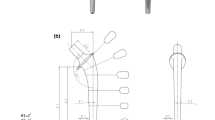Abstract
This study prospectively assessed the outcome of 134 cemented titanium stems and serum ion levels. The stems were polished (0.1 μm Ra) with circular cross section. At the end point, only one stem revision was performed for aseptic loosening, and two were planned due to subsidence greater than 5 mm. Non-progressive radiolucencies in zones 1 and 7 were observed in 16 hips at the cement-bone interface without osteolysis. Median serum titanium concentrations were below the detection limit (30 nmol/l) except in patients with failed stems. The overall stem survival rate was 97.7% at nine years, which is comparable to other series of cemented stems. The protective layer of titanium oxide coating the stem and a thick cement mantle may help resist aseptic loosening. In addition, satisfactory monitoring of the stem was reached using titanium serum level determination.
Résumé
Cette étude rapporte le suivi clinique prospectif d’une série de 134 tiges fémorales titane cimentées et l’évolution des taux de titane sérique. Les implants étaient en titane anodisé, lisses (0.1-microm Ra) et de section circulaire. Au recul moyen de 9 ans, le taux de survie était de 97,7%, ce qui est comparable aux autres séries de tiges cimentées. On notait une reprise pour descellement et deux révisions prévisibles pour un enfoncement supérieur à 5 mm. Des liserés non évolutifs étaient observés en zones 1 et 7 pour 16 hanches sans ostéolyse. La médiane du titane sérique était inférieure à la limite de détection (30 nmol/l) à l’exception des 3 échecs où les taux sont étaient nettement plus élevés. La couche protectrice d’oxyde de titane et l’épaisseur du manteau de ciment peuvent expliquer la résistance au descellement aseptique. Le taux de titane sérique semble intéressant pour la surveillance des tiges titanes cimentées.


Similar content being viewed by others
References
Barrack Rl (2000) Early failure of modern cemented stems. J Arthroplasty 15:1036–1050
Brodner W, Bitzan P, Meisinger V, Kaider A, Gottsauner-Wolf F, Kotz R (2003) Serum cobalt levels after metal-on-metal total hip arthroplasty. J Bone Joint Surg Am 85-A:2168–2173
Brooker AF, Bowerman JW, Robinson RA, Riley LH Jr (1973) Ectopic ossification following total hip replacement. Incidence and a method of classification. J Bone Joint Surg Am 55:1629–1632
Buly Rl, Huo MH, Salvati E, Brien W, Bansal M (1992) Titanium wear debris in failed cemented total hip arthroplasty: an analysis of 71 cases. J Arthroplasty 7:315–323
DeLee JG, Charnley J (1976) Radiological demarcation of cemented sockets in total hip replacement. Clin Orthop Relat Res 121:20–32
Dorr LD, Bloebaum R, Emmanual J, Meldrum R (1990) Histologic, biochemical, and ion analysis of tissue and fluids retrieved during total hip arthroplasty. Clin Orthop Relat Res 261:82–95
Ebramzadeh E, Normand PL, Sangiorgio SN, Llinas A, Gruen TA, McKellop HA, Sarmiento A (2003) Long-term radiographic changes in cemented total hip arthroplasty with six designs of femoral components. Biomaterials 24:3351–3363
Estok DM 2nd, Orr TE, Harris WH (1997) Factors affecting cement strains near the tip of a cemented femoral component. J Arthroplasty 12:40–48
Gruen TA, McNeice GM, Amstutz HC (1979) “Modes of failure” of cemented stem-type femoral components: a radiographic analysis of loosening. Clin Orthop Relat Res 141:17–27
Hamadouche M, Boutin P, Daussange J, Bolander ME, Sedel L (2002) Alumina-on-alumina total hip arthroplasty: a minimum 18.5-year follow-up study. J Bone Joint Surg Am 84-A:69–77
Harris WH (1994) Osteolysis and particle disease in hip replacement. A review. Acta Orthop Scand 65:113–123
Head WC, Bauk DJ, Emerson RH Jr (1995) Titanium as the material of choice for cementless femoral components in total hip arthroplasty. Clin Orthop Relat Res 311:85–90
Jacobs JJ, Skipor AK, Campbell PA, Hallab NJ, Urban RM, Amstutz HC (2004) Can metal levels be used to monitor metal-on-metal hip arthroplasties? J Arthroplasty 19(8 Suppl 3):59–65
Jacobs JJ, Skipor AK, Patterson LM, Hallab NJ, Paprosky WG, Black J, Galante JO (1998) Metal release in patients who have had a primary total hip arthroplasty. A prospective, controlled, longitudinal study. J Bone Joint Surg Am 80:1447–1458
Jergesen HE, Karlen JW (2002) Clinical outcome in total hip arthroplasty using a cemented titanium femoral prosthesis. J Arthroplasty 17:592–599
Kasai Y, Iida R, Uchida A (2003) Metal concentrations in the serum and hair of patients with titanium alloy spinal implants. Spine 28:1320–1326
Kelley SS, Fitzgerald RH Jr, Rand JA, Ilstrup DM (1993) A prospective randomized study of a collar versus a collarless femoral prosthesis. Clin Orthop Relat Res 294:114–122
Langlais F, Kerboull M, Sedel L, Ling RS (2003) The ‘French paradox’. J Bone Joint Surg Br 85:17–20
Lappalainen R, Santavirta SS (2005) Potential of coatings in total hip replacement. Clin Orthop Relat Res 430:72–79
Le Mouel S, Allain J, Goutallier D (1998) 10-year actuarial analysis of a cohort of 156 total hip prostheses of a cemented polished aluminum/polyethylene alloy (in French). Rev Chir Orthop Reparatrice Appar Mot 84:338–345
Leopold SS, Berger RA, Patterson L, Skipor AK, Urban RM, Jacobs JJ (2000) Serum titanium level for diagnosis of a failed, metal-backed patellar component. J Arthroplasty 15:938–943
Malchau H, Herberts P, Eisler T, Garellick G, Soderman P (2002) The Swedish Total Hip Replacement Register. J Bone Joint Surg Am 84-A(Suppl 2):2–20
Mcgrath LR, Shardlow DL, Ingham E, Andrews M, Ivory J, Stone MH, Fisher J (2001) A retrieval study of capital hip prostheses with titanium alloy femoral stems. J Bone Joint Surg Br 83:1195–1201
Scholl E, Eggli S, Ganz R (2000) Osteolysis in cemented titanium alloy hip prosthesis. J Arthroplasty 15:570–575
Thomas SR, Shukla D, Latham PD (2004) Corrosion of cemented titanium femoral stems. J Bone Joint Surg Br 86:974–978
Willert HG, Brobäck LG, Buchhorn GH, Jensen PH, Köster G, Lang I, Ochsner P, Schenk R (1996) Crevice corrosion of cemented titanium alloy stems in total hip replacements. Clin Orthop Relat Res 333:51–75
Author information
Authors and Affiliations
Corresponding author
Rights and permissions
About this article
Cite this article
Boyer, P., Lazennec, JY., Poupon, J. et al. Clinical and biological assessment of cemented titanium femoral stems: an 11-year experience. International Orthopaedics (SICOT) 33, 1209–1215 (2009). https://doi.org/10.1007/s00264-008-0678-9
Received:
Revised:
Accepted:
Published:
Issue Date:
DOI: https://doi.org/10.1007/s00264-008-0678-9




